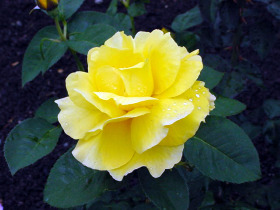 'Midas Touch' is a disease resistant, long lasting, repeat- blooming hybrid tea with wonderful fragrance
'Midas Touch' is a disease resistant, long lasting, repeat- blooming hybrid tea with wonderful fragranceRoses, Roses, Roses
Bare-root roses are available in garden centers now, and the selection is mind-boggling. Frequently called the queen of flowers, roses have played a starring role in my garden for decades. In my opinion, no other plant could possibly compete with the fragrance and beauty of a rose.Roses also have the reputation of being difficult to grow, but the challenge of growing healthy roses is part of their attraction. Luckily, rose breeders are leveling the playing field by introducing new varieties that tolerate less-than-perfect growing conditions. And because these new varieties are more adaptable -- even in my sunshine-challenged garden -- I can be successful. You can be successful with roses, too.
When you're buying roses for your garden, be sure to select fragrant varieties. Surprisingly, many beautiful roses have little fragrance. If you make room for some scented gems, they will perfume your entire garden.
Rules of the Road
Roses need lots of sunlight -- at least six hours a day -- or they won't flower freely. Good air circulation also is essential if you want to keep your roses in top form. Find out how large your plants will be at maturity and space them accordingly.
Eliminate weed competition by spreading a 3- or 4-inch mulch of shredded bark or other material under your roses. Because roses have shallow root systems, it's best to tread lightly when weeding around your plants.
Water your roses in the morning so the plants have time to dry out before nightfall. A drip irrigation system is probably your best bet because it delivers water directly to the root zones of the plants and doesn't wet the foliage.
And finally, if space is at a premium, grow vertically. Climbers and ramblers trained on a trellis or arbor can add drama, color, and fragrance to any garden. Just remember that over time climbing roses can get heavy, so be sure your supports are sturdy.
Bare-Root or Container-Grown Plants
There are two traditional planting times for roses; late winter to early spring, and in the fall. Bare-root roses, which are available now, are dug from the field during their dormant stage. The roots are plunged into a box or bag filled with sawdust, and the canes are dipped in wax to prevent premature growth while in transit and storage. Purchasing bare-root roses is sometimes an act of faith. Their dormant stage belies their potential, and there's really nothing to go by except the picture on the package.
On the other hand, bare-root roses are convenient little packages. They're relatively inexpensive, and you can fit a lot of them into the trunk of your car!
Container-grown roses take a lot of the guesswork out of choosing roses for your garden. You can see the flower color and size and inspect the canes and foliage for pest problems prior to purchase. Container roses may be available most any time of the year, but early fall is usually the best time to buy and plant them.
Choosing a Site and Planting
Roses do best when they get at least 6 hours of direct sun per day. Morning sun dries the foliage early in the day, which may be wet from overnight rainfall or morning dew. Since dampness can encourage fungal disease problems, it's essential to provide adequate sunshine and air circulation around each plant.
Here are some planting tips:
1. Dig Deep. Whether you are preparing a large bed for several roses or setting out a single plant, it pays to take time preparing the soil. For a new bed, I start by loosening the top 8 to 10 inches of soil and mixing in plenty of well-rotted manure or compost. Next, I broadcast about 1/2 cup of superphosphate and 1 cup of rose fertilizer over the area. I then mix everything together, level it and let the soil settle for a week or two before planting.
For a single bare-root plant, I dig a hole 14 to 16 inches wide and 12 to 18 inches deep, amend the soil with organic matter and fertilizer as I do with a bed, then plant the rose. For a container rose, the planting hole should be the same depth as the container and about 18 inches wide. I loosen the soil all the way around the rootball to expose the roots, spread them out a bit, then set the plant in the hole at about the same depth it was growing in the pot. I fill the hole with soil that's been amended with compost, superphosphate, and rose fertilizer, and tamp gently to firm the soil down around the roots.
2. Water Well. The first few weeks after planting are critical for new roses. Most important is regular watering. Roses need about an inch of water per week. Building a basin beneath each rose bush and filling it once or twice at watering time will allow the moisture to trickle down slowly and wet the entire root mass.
No Room For Roses?
Roses grow well in containers if garden space is at a premium. Use a 16-inch pot to accommodate roots, and fill it with a good grade of commercial potting soil. Remember that potted roses must have winter protection because their roots are exposed to winter air temperatures. Put them on wheels so you can wheel them into an unheated garage for the winter months.
Armed with these guidelines, planning for a rosy future should be easy. Enjoy!
No comments:
Post a Comment